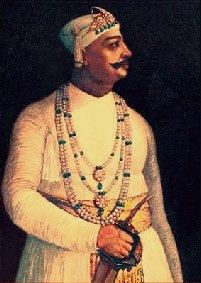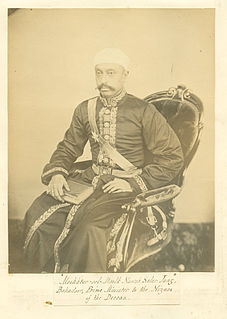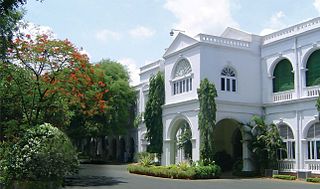
- Azam Jah, Nawab Mir Himayat Ali Khan Bahadur, Prince of Berar (1907-1970)

- (1) Azmet Jah, Nawab Mir Muhammad Azmet Ali Khan Bahadur, Prince of Berar (born 1960)
- (2) Murad Jah, Nawab Mir Muhammad Murad ‘Ali Khan Bahadur (born 1998)
- (3) Prince Azam Jah, Nawab Mir Alexander Azam ‘Ali Khan Bahadur (born 1979)
- (1) Azmet Jah, Nawab Mir Muhammad Azmet Ali Khan Bahadur, Prince of Berar (born 1960)
- (4) Prince Muffakham Jah, Nawab Mir Karamat ‘Ali Khan Bahadur (born 1939)
- (5) Prince Rafa'at Jah, Nawab Mir Rafa'at Ali Khan Bahadur (born 1965)
- (6) Prince Farhat Jah, Nawab Mir Farhat Ali Khan Bahadur (born 1971)
- Prince Mua'zzam Jah, Nawab Mir Shuja'at Ali Khan Bahadur (1907-1987)
- (7) Prince Shahamat Jah, Nawab Mir Shahamat Ali Khan Bahadur (born 1957)
- Prince Kazim Jah, Nawab Mir Kazim Ali Khan Bahadur (1912-1952)
- (8) Prince Ahmad Jah, Nawab Mir Ahmad Ali Khan Bahadur
- (9) Sahibzada Mir Arshad Ali Khan
- (10) Prince Baqir Jah, Nawab Mir Baqir Ali Khan Bahadur
- (11) Sahibzada Mir Muhammad Jafar Ali Khan (born 1964)
- (12) Sahibzada Mir Kausar Ali Khan (born 1966)
- (8) Prince Ahmad Jah, Nawab Mir Ahmad Ali Khan Bahadur
- Prince Abid Jah, Nawab Mir Abid ‘Ali Khan Bahadur (1913-1988)
- (13) Sahibzada Mir Banda ‘Ali Khan (born 1951)
- (14) Sahibzada Mir Mushraf ‘Ali Khan (born 1969)
- (13) Sahibzada Mir Banda ‘Ali Khan (born 1951)
- Prince Hashmat Jah, Nawab Mir Hashmat Ali Khan Bahadur (1913-1988)
- (15) Nawab Mir Hassan Ali Khan Bahadur (born 1939)
- (16) Nawab Mir Hussein Ali Khan Bahadur (born 1942)
- (17) Nawab Mir Ata'ullah Khan Bahadur (born 1953)
- (18) Nawab Mir Habib Khan Bahadur (born 1955)
- (19) Nawab Mir Rahmat Ali Khan Bahadur (born 1963)
- Prince Hashim Jah, Nawab Mir Muhammad Hashim Ali Khan Bahadur (1913-1991)
- (20) Nawab Mir Shamsher Ali Khan Bahadur (born 1941)
- (21) Nawab Mir Miraj Ali Khan Bahadur (born 1941)
- (22) Nawab Mir Shahamat Ali Khan Bahadur (born 1942)
- (23) Sahibzada Mir Bakhtiar Ali Khan (born 1964)
- (24) Sahibzada Mir Sulaiman Ali Khan (born 1980)
- (25) Nawab Mir Kawkab Ali Khan Bahadur (born 194?)
- (26) Nawab Mir Zamin Ali Khan Bahadur (born 1948)
- (27) Sahibzada Mir Muhammad Jafar Ali Khan (born 1978)
- (28) Sahibzada Mir Haidar Ali Khan (born 2000)
- (29) Sahibzada Mir Murtaza Ali Khan (born 2007)
- (27) Sahibzada Mir Muhammad Jafar Ali Khan (born 1978)
- (30) Nawab Mir Askar Ali Khan Bahadur (born 1950?)
- (31) Sahibzada Mir Murtaza Ali Khan
- (32) Nawab Mir Nusrat Ali Khan Bahadur (born 1950?)
- (33) Sahibzada Mir Muhammad Hussein Ali Khan (born 1970)
- (34) Nawab Mir Karam Ali Khan Bahadur (born 1956)
- (35) Sahibzada Mir Osman Ali Khan (born 1985)
- (36) Nawab Mir Najaf Ali Khan (born 1964)
- (37) Sahibzada Mir Muhammad Anas Khan (born 2001)
- Prince Taqi Jah, Nawab Mir Taqi Ali Khan Bahadur (1913-1985)
- (38) Nawab Mir Naqi Ali Khan Bahadur (born 1938)
- (39) Nawab Mir Jafar Ali Khan Bahadur
- Prince Sa'adat Jah, Nawab Mir Sa'adat Ali Khan Bahadur (1917-1988)
- (40) Nawab Mir Firasat Ali Khan Bahadur
- (41) Sahibzada Mir Riyasat Ali Khan
- (42) Sahibzada Mir Karamat Ali Khan
- (43) Sahibzada Mir Azmet Ali Khan (born 1963)
- (44) Nawab Mir Siyadat Ali Khan Bahadur
- (45) Sahibzada Mir Iradat Ali Khan Bahadur (born 1963)
- (46) Nawab Mir Miraj Ali Khan Bahadur (born 1967)
- (40) Nawab Mir Firasat Ali Khan Bahadur
- Azam Jah, Nawab Mir Himayat Ali Khan Bahadur, Prince of Berar (1907-1970)
Line of succession in September 1948

- (1) Azam Jah, Nawab Mir Himayat Ali Khan Bahadur, Prince of Berar (born February 1907)
- (2) Nawab Mir Barakat Ali Khan Bahadur (born October 1933)
- (3) Prince Muffakham Jah, Nawab Mir Karamat ‘Ali Khan Bahadur (born February 1939)
- (4) Prince Mua'zzam Jah, Nawab Mir Shuja'at Ali Khan Bahadur (born December 1907)
- (5) Nawab Mir Ahmad Ali Khan Bahadur (born March 1912)
- (6) Prince Kasim Jah, Nawab Mir Kasim Ali Khan Bahadur (born July 1912)
- (7) Prince Ahmad Jah, Nawab Mir Ahmad Ali Khan Bahadur
- (8) Prince Baqir Jah, Nawab Mir Baqir Ali Khan Bahadur
- (9) Prince Hashmat Jah, Nawab Mir Hashmat Ali Khan Bahadur (born January 1913)
- (10) Nawab Mir Hassan Ali Khan Bahadur (born 1939)
- (11) Nawab Mir Hussein Ali Khan Bahadur (born 1942)
- (12) Prince Hashim Jah, Nawab Mir Muhammad Hashim Ali Khan Bahadur (born March 1913)
- (13) Nawab Mir Shamsher Ali Khan Bahadur (born 1941)
- (14) Nawab Mir Miraj Ali Khan Bahadur (born 1942)
- (15) Nawab Mir Shahamat Ali Khan Bahadur (born 1942)
- (16) Nawab Mir Kawkab Ali Khan Bahadur (born 194?)
- (17) Prince Taqi Jah, Nawab Mir Taqi Ali Khan Bahadur (born June 1913)
- (18) Nawab Mir Naqi Ali Khan Bahadur (born 1938)
- (19) Nawab Mir Jafar Ali Khan
- (20) Prince Basharat Jah, Nawab Mir Basharat ‘Ali Khan Bahadur (born June 1915)
- (21) Prince Rajjab Jah, Nawab Mir Rajjab ‘Ali Khan Bahadur (born May 1917)
- (22) Prince Sa'adat Jah, Nawab Mir Sa'adat Ali Khan Bahadur (born November 1917)
- (23) Nawab Mir Firasat Ali Khan Bahadur
- (24) Nawab Mir Siyadat Ali Khan Bahadur
- (25) Prince Zulfiqar Jah, Nawab Mir Zulfiqar ‘Ali Khan Bahadur (born May 1943)
- (26) Prince Imdad Jah, Nawab Mir Imdad Ali Khan Bahadur (born September 1944)
- (27) Prince Nawazish Jah, Nawab Mir Nawazish Ali Khan Bahadur (born October 1944)
- (28) Prince Fazal Jah, Nawab Mir Fazal Ali Khan Bahadur (born March 1946)
- (29) Prince Bhojat Jah, Nawab Mir Bhojat Ali Khan Bahadur (born October 1947) [ citation needed ]
- (1) Azam Jah, Nawab Mir Himayat Ali Khan Bahadur, Prince of Berar (born February 1907)
Related Research Articles

Nawab also spelt Nawaab, Navaab, Navab, Nowab, Nabob, Nawaabshah, Nawabshah or Nobab, is a Royal title indicating a sovereign ruler, often of a South Asian state, in many ways comparable to the western title of King. The relationship of a Nawab to the Emperor of India has been compared to that of the King of Saxony to the German Emperor. In earlier times the title was ratified and bestowed by the reigning Mughal emperor to semi-autonomous Muslim rulers of subdivisions or princely states in the Indian subcontinent loyal to the Mughal Empire i.e. Nawabs of Bengal. The title is common among Muslim rulers of South Asia as an equivalent to the title Maharaja, however it is not exclusive to Muslims only.

The Nizams were the 18th-through-20th-century rulers of Hyderabad. Nizam of Hyderabad was the title of the monarch of the Hyderabad State. Nizam, shortened from Nizam-ul-Mulk, meaning Administrator of the Realm, was the title inherited by Asaf Jah I. He was the viceroy of the Great Mughal in the Deccan, the premier courtier in Mughal India in 1724, and the founding "Nizam of Hyderabad".

Azam Jah, Damat Walashan Sahebzada Nawab Sir Mir Himayat Ali Khan Siddiqi Bahadur Bayaffendi was the eldest son of the seventh and last Nizam of Hyderabad, Mir Osman Ali Khan Siddiqi Asif Jah VII and Sahebzadi Azam unisa Begum, daughter of Sahebzada Mir Jhangir Ali Khan Siddiqi. In 1936 he was given the courtesy title of Prince of Berar, a territory of the Nizam then leased in perpetuity to the British and administered by them.

Asaf Jah VI Sir Mir Mahboob Ali Khan Siddiqi Bayafandi was the 6th Nizam of Hyderabad. He ruled Hyderabad state, one of the Princely states in India between 1869 and 1911.

Paigah is a family in the senior aristocracy of Hyderabad State and each maintained his own court, individual palaces, and a standing army of about fourteen thousand troops, both infantry and cavalry.

Nawab Mir Nizam Ali Khan Siddiqi, Asaf Jah II was the 2nd Nizam of Hyderabad State in South India between 1762 and 1803. He was born on 7 March 1734 as fourth son to Asaf Jah I and Umda Begum. His official name is Asaf Jah II, Nizam ul-Mulk, Nizam ud-Daula, Nawab Mir Nizam 'Ali Khan Siddiqi Bayafandi Bahadur, Fath Jang, Sipah Salar, Nawab Subedar of the Deccan.

Nawab Mir Akbar Ali Khan Siddiqi Bayafandi Bahadur, Sikander Jah, Asaf Jah III, was the 3rd Nizam/Ruler of Hyderabad, India from 1803 to 1829.
Nawab Sir Ahmed Hussain, Amin Jung Bahadur, KCIE, CSI, LLD (Osmania), MA, BL (Madras) was born in Madras on 11 August 1863 in the family of a leading businessman.

Begum Sahiba Hatice Hayriye Ayşe Dürrüşehvar Sultan was the daughter of Abdulmejid II of the Ottoman dynasty, who was the last heir apparent to the Ottoman Imperial throne and the last Caliph of the Ottoman Caliphate. She held the titles of Princess of Berar through marriage, and Imperial Princess of the Ottoman Empire by birth before the monarchy's abolition in 1922.

Sir Mir Turab Ali Khan, Salar Jung I,, known simply as Salar Jung I, was an Indian nobleman who served as Prime Minister of Hyderabad State between 1853 until his death in 1883. He also served as regent for the sixth Nizam, Asaf Jah VI between 1869 and 1883.

Sahebzada Mir Barkat Ali Khan Siddiqi Mukarram Jah Asaf Jah VIII (Telugu: మీర్ బర్కాత్ ఆలీ ఖాన్ ముకరం జా ఆసాఫ్ జా), less formally known as Mukarram Jah, has been the titular Nizam of Hyderabad since the death of his grandfather in 1967.

Nawab Fazal Nawaz Jung Bahadur was a noted Hyderabadi politician and financier during the period of the Nizam of Hyderabad Mir Osman Ali Khan, Asaf Jah VII.

Alivardi Khan was the Nawab of Bengal from 1740 to 1756. He toppled the Nasiri Dynasty of the Nawabs and took powers of the Nawab. He is also one of the few Mughal-era leaders known for his victory during the Battle of Burdwan against the Maratha Empire during the Maratha invasions of Bengal.

The Asaf Jahi was a dynasty which ruled the Kingdom of Hyderabad. It had Turkic origins tracing to the region around Samarkand. The family came to India in the late 17th century, and became employees of the Mughal Empire. As the Mughals, of Turco-Mongol origin, were great patrons of Persian culture, language, and literature, the family found a ready patronage.

Moazzam Jah, Walashan Shahzada Nawab Mir Sir Shuja’at ‘Ali Khan Siddiqui Bahadur, KCIE, was the son of the last Nizam of Hyderabad, Osman Ali Khan, Asaf Jah VII and his first wife Dulhan Pasha Begum.

Mir Hashim Ali Khan was commandant of the 2nd Lancers, Hyderabad Imperial Service Troops.

Ghazi ud-Din Khan Feroze Jung III or Nizam Shahabuddin Muhammad Feroz Khan Siddiqi Bayafandi also known by his sobriquet Imad-ul-Mulk, was the subedar of Assam allied with the Maratha Empire, who were often described as a de facto ruler of the Mughal Empire. He was the son of Ghazi ud-Din Khan Feroze Jung II and a grandson of the founder of the Nizam Dynasty, Nizam ul Mulk Asaf Jah. A controversial figure, Imad is well known for assassinating Mughal Emperor Alamgir II and for imprisoning and blinding Emperor Ahmad Shah Bahadur, and torturing their family members. He was declared to be an apostate by various Islamic scholars and by Durrani Emperor Ahmad Shah Abdali.After the death of his father in 1752, he was recommended by Nawab Safdar Jung to be appointed as Mir Bakhshi and received the titles of Amir ul-Umara and Imad ul-Mulk.
Nawab Walashan Mir Azmet Ali Khan Siddiqi Bayafandi Bahadur, commonly known as Prince Azmet Jah, is an Indian-British professional photographer and a descendant of the Asif Jahi dynasty of Hyderabad and the Imperial House of Osman.

Administrative Staff College of India (ASCI), was started jointly by the Government of India and the representatives of industry as an autonomous institute in the year 1956 to impart training in the field of management development. It is located at the palace of the erstwhile Prince of Berar known as Bella Vista at Hyderabad who was heir apparent to the (throne) of Hyderabad. Prince of Berar, Nawab Mir Himayat Ali Khan, Azam Jah Bahadur, the elder son of the Seventh Nizam of Hyderabad, Mir Osman Ali Khan.

Nawab Mir Khudrath Nawaz Jung Bahadur (1896–1971) He was the youngest son of Nawab Mir Jahanghir Ali Khan Bahadur who was the son of Nawab Roshan-ud-Daulah, the younger brother of The V Nizam of Hyderabad Afzal-ud-Daulah of the Asaf Jahi family of Hyderabad state. His elder sister Sahebzadi Azmath unnisa Begum was the first legally wedded wife of the 7th Nizam Mir Osman Ali Khan in the year 1920. He was the first brother-in-law of Nizam VII Mir Osman Ali Khan. and the Maternal uncle of Azam Jah, Moazzam Jah, and Shehzadi Pasha. He held many prestigious official positions in the Nizam's Darbar, Army and Administration Offices.